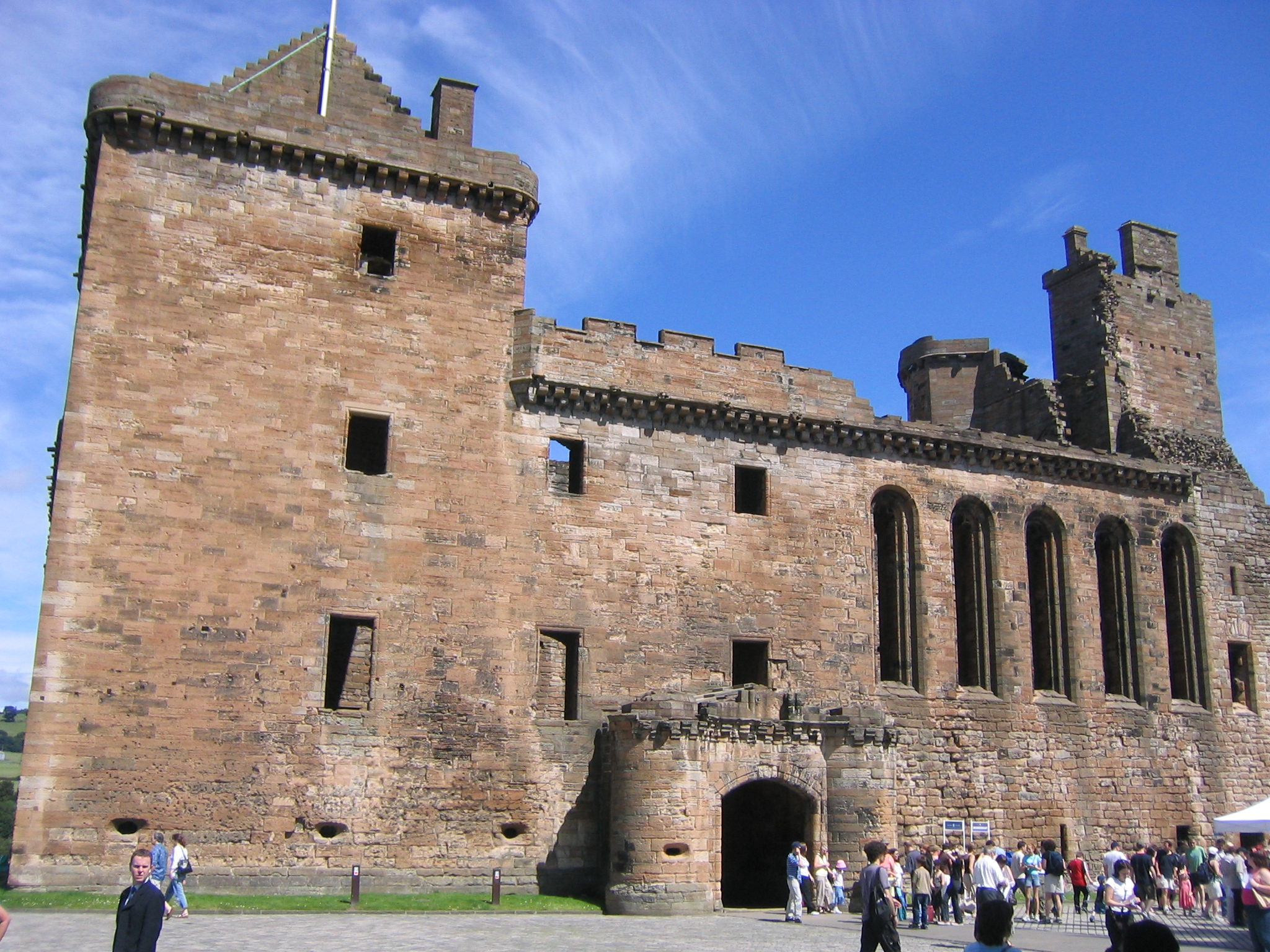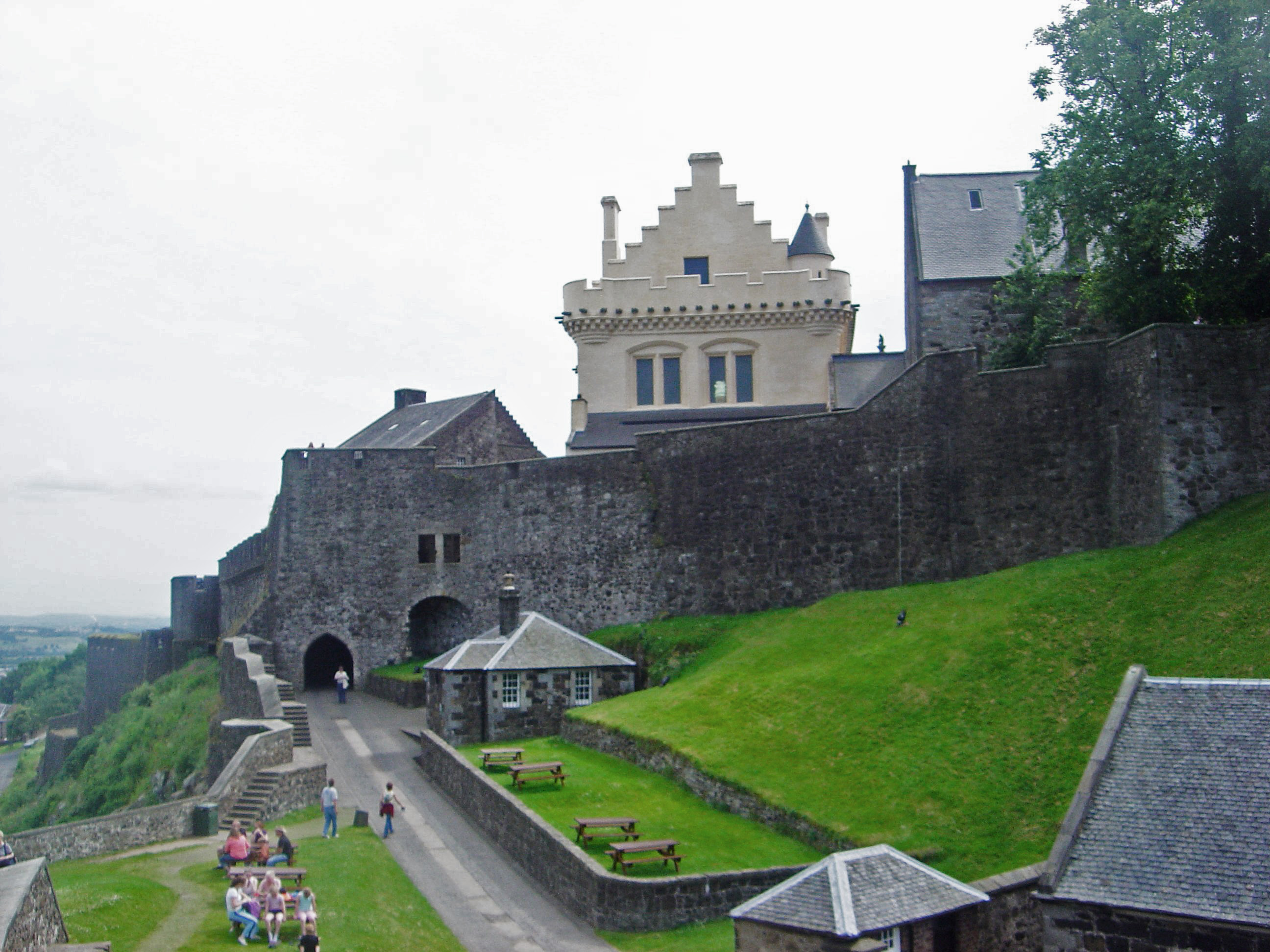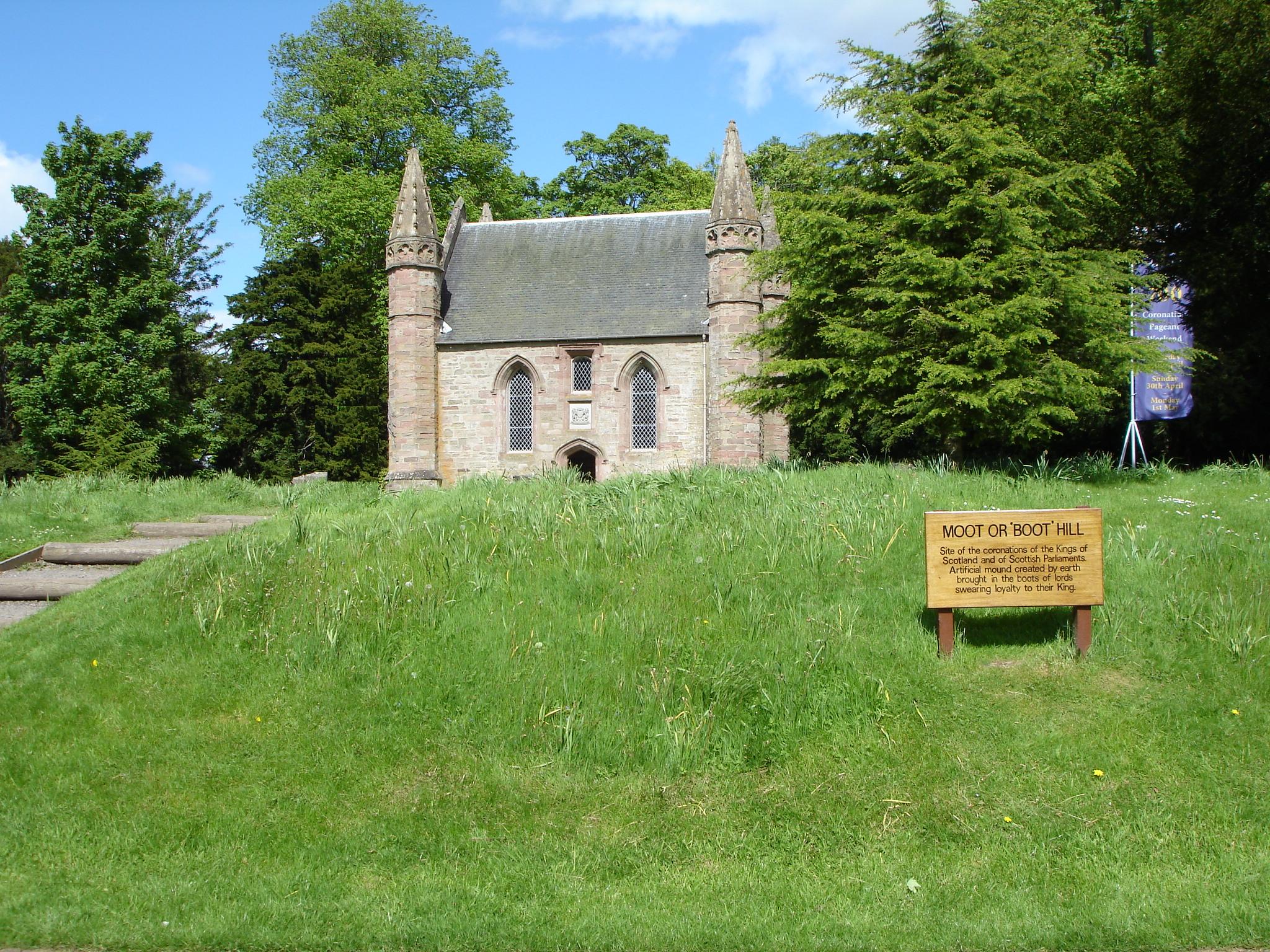|
John Somerville, 3rd Lord Somerville
John Somerville, 3rd Lord Somerville (died 1491) was the son of William Somerville, 2nd Lord Somerville and Janet Mowat. He was a member of the Scottish Parliament. In 1449 he fought with the Scots who defeated the English at Sark. He was also present at the siege of Roxburgh in 1460 during which James II of Scotland died. Family Somerville first married Helen Hepburn (daughter of Lord Hailes). He was succeeded by their grandson John Somerville, 4th Lord Somerville, the son of William, Master of Somerville. Their daughter Elizabeth married Gillespic (Archibald) Campbell, Master of Campbell, and was the mother of Colin Campbell, 1st Earl of Argyll. After Helen's death, John married Marion Baillie, daughter of Sir William Baillie of Lamington. John's son by Marion Baillie, John Somerville of Quothquan, 1st Baron of Cambusnethan, was called 'Red Bag' on account of the red satin satchel he carried while hawking. Red-Bag would later be involved in rivalry over the Somerville famil ... [...More Info...] [...Related Items...] OR: [Wikipedia] [Google] [Baidu] |
William Somerville, 2nd Lord Somerville
William Somerville, 2nd Lord Somerville (died 20 August 1456) was a member of the Scottish Parliament in the mid-15th century. He is the first person to have clearly held the title Lord Somerville, having been created such in 1445, although other sources suggest that his father was the first Lord. William Somerville was the son of Sir Thomas Somerville and his wife Janet Stewart. William Somerville married Janet Mowat. Their eldest daughter Marie married Ralph Weir, and another daughter Janet married James Cleilland of Cleilland. A younger son, William Somerville, married Margaret Hamilton of Preston and founded the Somerville of Plane family near Stirling. William's older son and heir, John Somerville, 3rd Lord Somerville, married Helen Hepburn, daughter of Sir Adam Hepburn by Janet Borthwick, then secondly married Mariotta Baille. William died on 20 August 1456 of a surfeit of fruit. In March 1478 his widow Janet, Lady Craigmillar sued John, Lord Somerville, for goods and si ... [...More Info...] [...Related Items...] OR: [Wikipedia] [Google] [Baidu] |
Linlithgow Palace
The ruins of Linlithgow Palace are located in the town of Linlithgow, West Lothian, Scotland, west of Edinburgh Edinburgh ( ; gd, Dùn Èideann ) is the capital city of Scotland and one of its 32 Council areas of Scotland, council areas. Historically part of the county of Midlothian (interchangeably Edinburghshire before 1921), it is located in Lothian .... The palace was one of the principal residences of the monarchs of Kingdom of Scotland, Scotland in the 15th and 16th centuries. Although maintained after Scotland's monarchs left for England in 1603, the palace was little used, and was burned out in 1746. It is now a visitor attraction in the care of Historic Environment Scotland. Origins A royal manor existed on the site from the 12th century. This was enclosed by a timber palisade and outer fosse to create a fortification known as 'the Peel', built in 1301/2 by occupying English forces under Edward I of England, Edward I to designs by James of Saint Geo ... [...More Info...] [...Related Items...] OR: [Wikipedia] [Google] [Baidu] |
Year Of Birth Unknown
A year or annus is the orbital period of a planetary body, for example, the Earth, moving in its orbit around the Sun. Due to the Earth's axial tilt, the course of a year sees the passing of the seasons, marked by change in weather, the hours of daylight, and, consequently, vegetation and soil fertility. In temperate and subpolar regions around the planet, four seasons are generally recognized: spring, summer, autumn and winter. In tropical and subtropical regions, several geographical sectors do not present defined seasons; but in the seasonal tropics, the annual wet and dry seasons are recognized and tracked. A calendar year is an approximation of the number of days of the Earth's orbital period, as counted in a given calendar. The Gregorian calendar, or modern calendar, presents its calendar year to be either a common year of 365 days or a leap year of 366 days, as do the Julian calendars. For the Gregorian calendar, the average length of the calendar year ... [...More Info...] [...Related Items...] OR: [Wikipedia] [Google] [Baidu] |
Lord Somerville
Lord Somerville is a title in the Peerage of Scotland which is subject to a number of ambiguities. The date of creation is not known with certainty but it was probably created about 1435 for Thomas Somerville, Justiciar of Scotland. The title was omitted in 1606 when an ordered list of the Scottish peerage was produced following the union of the Scottish and English crowns, and the title was not used during the 17th century. In 1723, however, the House of Lords ratified and acknowledged the title for James Somerville the 13th Lord. The consecutive numbers ascribed to the numerous Lords differ according to which authority is consulted. The list below uses the numbers favoured by Burkes Peerage. The Somervilles claim descent from William de Somerville, given Carnwath by David I of Scotland in the 12th century. A family history was written by James Somerville, 11th Lord Somerville in 1679. He related that William the Lion made John Somerville, his falconer, baron of Linton in R ... [...More Info...] [...Related Items...] OR: [Wikipedia] [Google] [Baidu] |
James Somerville (family Historian)
James Somerville (1632–1690) was a Scottish family historian. A youthful soldier of the Wars of the Three Kingdoms, he like his father declined to claim the title Lord Somerville, but wrote an extensive work on his ancestry, later edited by Walter Scott. Early life Baptised on 24 January 1632 at Newhall in Lanarkshire, he was eldest and only surviving son of James Somerville of The Drum (by right, tenth Lord Somerville) and Lilias, second daughter of Sir James Bannatyne of Newhall, a lord of session. James's father had gained military experience in France, as an officer in the Scots guard of Louis XIII. On the outbreak of the First Bishops' War in 1639, the elder Somerville joined the covenanting levies under General Alexander Leslie, and with the rank of major had a leading command at the siege of Edinburgh Castle in 1640. James joined his father's company at this siege. Campaign against Cromwell In 1645 the teenage Somerville was present at David Leslie's first cavalry m ... [...More Info...] [...Related Items...] OR: [Wikipedia] [Google] [Baidu] |
Walter Scott
Sir Walter Scott, 1st Baronet (15 August 1771 – 21 September 1832), was a Scottish novelist, poet, playwright and historian. Many of his works remain classics of European and Scottish literature, notably the novels ''Ivanhoe'', '' Rob Roy'', '' Waverley'', '' Old Mortality'', ''The Heart of Mid-Lothian'' and '' The Bride of Lammermoor'', and the narrative poems '' The Lady of the Lake'' and '' Marmion''. He had a major impact on European and American literature. As an advocate, judge and legal administrator by profession, he combined writing and editing with daily work as Clerk of Session and Sheriff-Depute of Selkirkshire. He was prominent in Edinburgh's Tory establishment, active in the Highland Society, long a president of the Royal Society of Edinburgh (1820–1832), and a vice president of the Society of Antiquaries of Scotland (1827–1829). His knowledge of history and literary facility equipped him to establish the historical novel genre as an exemplar of Eur ... [...More Info...] [...Related Items...] OR: [Wikipedia] [Google] [Baidu] |
Drumlanrig
Drumlanrig (Scottish Gaelic: ''Druim Lannraig'') is a settlement in Dumfries and Galloway, Scotland, which is best known for nearby Drumlanrig Castle. The earliest record for Drumlanrig is from 1384, spelled ''Drumlangryg''. There are a number of possible etymologies for the name. It may represent Cumbric ''drum'' 'ridge' + ''-lanerc'' 'small area of cleared woodland'. However, the first element may also be Gaelic ''druim '''ridge', either added to a Cumbric name or to Scots Scots usually refers to something of, from, or related to Scotland, including: * Scots language, a language of the West Germanic language family native to Scotland * Scots people, a nation and ethnic group native to Scotland * Scoti, a Latin na ... ''*lang-rigg'' 'long ridge'. References External linksOfficial website for the castle [...More Info...] [...Related Items...] OR: [Wikipedia] [Google] [Baidu] |
George Douglas, 4th Earl Of Angus
George Douglas, 4th Earl of Angus, Lord Douglas, Abernethy and Jedburgh Forest (c. 1427 – 12 March 1463)Alan R. Borthwick, 'Douglas, George, fourth earl of Angus (c.1417–1463)’, ''Oxford Dictionary of National Biography'', Oxford University Press, 2004. was a Scottish nobleman. He was the son of William Douglas, 2nd Earl of Angus and Margaret Hay of Yester. Known as the Great Earl of Angus. He succeeded to the Earldom following the death of his childless brother James Douglas, 3rd Earl of Angus in 1446. He was to become the first Red Chief of Douglas. Red Douglas and the Stewart connection The chief line of the family were the Earls of Douglas which represented the "Black" line, whereas Angus represented the "Red" Line. Both branches were descended through bastardy from William the Hardy, Lord of Douglas. The Earl of Douglas descended through Archibald the Grim, an illegitimate son of Sir James Douglas. The 4th Earl of Angus' grandfather was an illegitimate child of Wi ... [...More Info...] [...Related Items...] OR: [Wikipedia] [Google] [Baidu] |
James IV Of Scotland
James IV (17 March 1473 – 9 September 1513) was King of Scotland from 11 June 1488 until his death at the Battle of Flodden in 1513. He inherited the throne at the age of fifteen on the death of his father, James III, at the Battle of Sauchieburn, following a rebellion in which the younger James was the figurehead of the rebels. James IV is generally regarded as the most successful of the Stewart monarchs. He was responsible for a major expansion of the Scottish royal navy, which included the founding of two royal dockyards and the acquisition or construction of 38 ships, including the '' Michael'', the largest warship of its time.T. Christopher Smout, ''Scotland and the Sea'' (Edinburgh: Rowman and Littlefield, 1992), , p. 45. James was a patron of the arts and took an active interest in the law, literature and science, even personally experimenting in dentistry and bloodletting. With his patronage the printing press came to Scotland, and the Royal College of Surgeons ... [...More Info...] [...Related Items...] OR: [Wikipedia] [Google] [Baidu] |
James III Of Scotland
James III (10 July 1451/May 1452 – 11 June 1488) was King of Scots from 1460 until his death at the Battle of Sauchieburn in 1488. He inherited the throne as a child following the death of his father, King James II, at the siege of Roxburgh Castle. James III's reign began with a minority that lasted almost a decade, during which Scotland was governed by a series of regents and factions who struggled for possession of the young king, before his personal rule began in 1469. James III was an unpopular and ineffective king, and was confronted with two major rebellions during his reign. He was much criticised by contemporaries and later chroniclers for his promotion of unrealistic schemes to invade or take possession of Brittany, Guelders and Saintonge at the expense of his regular duties as king. While his reign saw Scotland reach its greatest territorial extent with the acquisition of Orkney and Shetland through his marriage to Margaret of Denmark, James was accused of d ... [...More Info...] [...Related Items...] OR: [Wikipedia] [Google] [Baidu] |
Parliament Of Scotland
The Parliament of Scotland ( sco, Pairlament o Scotland; gd, Pàrlamaid na h-Alba) was the legislature of the Kingdom of Scotland from the 13th century until 1707. The parliament evolved during the early 13th century from the king's council of bishops and earls, with the first identifiable parliament being held in 1235 during the reign of Alexander II, when it already possessed a political and judicial role. A unicameral institution, for most of its existence the Parliament consisted of the three estates of clergy, nobility, and the burghs. By the 1690s it comprised the nobility, the shires, the burghs, and various officers of state. Parliament gave consent for the raising of taxation and played an important role in the administration of justice, foreign policy, war, and the passing of a broad range of legislation. Parliamentary business was also carried out by "sister" institutions, such as General Councils or Conventions of Estates, which could both carry out much busi ... [...More Info...] [...Related Items...] OR: [Wikipedia] [Google] [Baidu] |
Adam Hepburn, Master Of Hailes
Adam Hepburn, Master of Hailes (after 1432 – 1479) was Sheriff of Berwickshire in April 1467, and had a charter of confirmation of Dunsyre in the sheriffdom of Lanarkshire, dated 13 October 1475, being thereafter designated 'of Dunsyre'. Family Adam Hepburn, Master of Hailes, was the son of Sir Patrick Hepburn, 1st Lord Hailes and Ellen Wallace. He was not of age to marry on 2 February 1448, the date of the marriage contract agreed between his father, and Alexander Home, 1st Lord Home, which settled the contract of marriage between Adam and Helen Home, Sir Alexander's daughter by his spouse Marion Lauder. Children # Patrick Hepburn, 1st Earl of Bothwell (c. 1452 – 18 October 1508). # George Hepburn (c. 1454 – 9 September 1513) #Margaret Hepburn (c. 1456 – 8 November 1542 married Sir David Wemyss of Wemyss and (bef 4 Dec 1488) Henry Sinclair, 4th Lord Sinclair. # Adam Hepburn (c. 1457 – 9 September 1513) #Elizabeth (Agnes) Hepburn (born c. 1461) marri ... [...More Info...] [...Related Items...] OR: [Wikipedia] [Google] [Baidu] |




.jpg)
